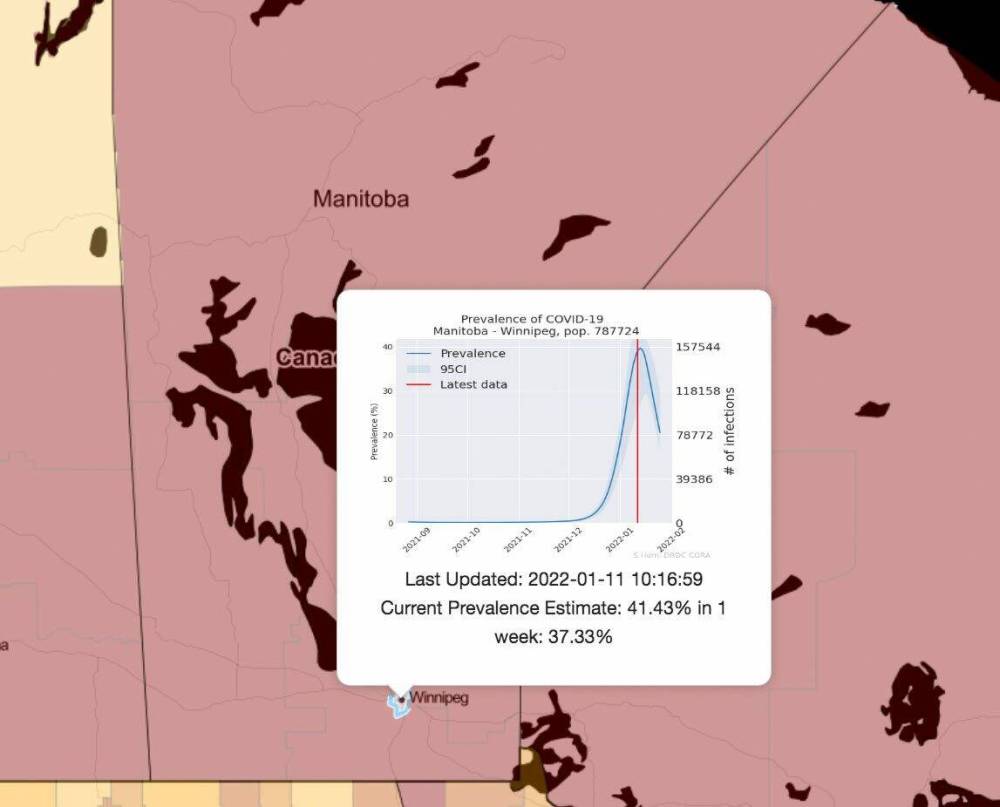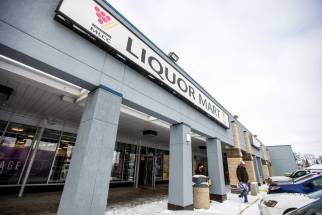Military research database estimates Winnipeg case rate of 40 per cent
Read this article for free:
or
Already have an account? Log in here »
To continue reading, please subscribe:
Monthly Digital Subscription
$0 for the first 4 weeks*
- Enjoy unlimited reading on winnipegfreepress.com
- Read the E-Edition, our digital replica newspaper
- Access News Break, our award-winning app
- Play interactive puzzles
*No charge for 4 weeks then price increases to the regular rate of $19.00 plus GST every four weeks. Offer available to new and qualified returning subscribers only. Cancel any time.
Monthly Digital Subscription
$4.75/week*
- Enjoy unlimited reading on winnipegfreepress.com
- Read the E-Edition, our digital replica newspaper
- Access News Break, our award-winning app
- Play interactive puzzles
*Billed as $19 plus GST every four weeks. Cancel any time.
To continue reading, please subscribe:
Add Free Press access to your Brandon Sun subscription for only an additional
$1 for the first 4 weeks*
*Your next subscription payment will increase by $1.00 and you will be charged $16.99 plus GST for four weeks. After four weeks, your payment will increase to $23.99 plus GST every four weeks.
Read unlimited articles for free today:
or
Already have an account? Log in here »
Hey there, time traveller!
This article was published 11/01/2022 (1431 days ago), so information in it may no longer be current.
OTTAWA — As many as 41 per cent of Winnipeggers might have active COVID-19, military modelling suggests — one week after the province acknowledged it can no longer accurately record the soaring number of cases.
That estimated prevalence is based on the typical ratio of known cases to asymptomatic ones that don’t ever get tested, the timelines people incubate the novel coronavirus and when they are most infectious to others, according to a dashboard designed by Defence Research and Development Canada, a government agency that advises the Canadian Armed Forces.
“The numbers found in this model are not case numbers but rather estimates based on existing epidemiological information,” a military spokesperson wrote Tuesday.
“The numbers found in this model are not case numbers but rather estimates based on existing epidemiological information.” – Military spokesperson
The Canadian military health system uses this tool “to support local risk assessment and related advice provided to commanders,” including abroad.
It is not used to advise any government.
In data updated Tuesday morning, the dashboard suggests some 41.4 per cent of the Winnipeg Regional Health Authority’s population has active COVID-19, amounting to 326,317 people.
Officially, Manitoba has 22,605 lab-confirmed, active COVID-19 cases in Winnipeg — though the province says that’s vastly under-reported, as PCR lab tests are being rationed to select groups.
Most Manitobans with symptoms receive rapid antigen tests, whose results are not recorded by the province. Those with a positive result on a rapid test are supposed to isolate at home.

On Jan. 5, Manitoba deputy chief provincial public health officer Dr. Jazz Atwal said the number of cases was likely eight to 10 times higher than those detected in PCR tests.
Manitoba Health could not say Tuesday whether that extrapolation still stands.
There were 33,617 lab-confirmed cases for all of Manitoba, as of Tuesday morning. Under the range Atwal mentioned, that would amount to between 268,936 to 336,170 total cases, which equals between 19.5 and 24.3 per cent of the provincial population having active COVID-19.
The military modelling pegs that prevalence a bit higher, at 24.5 per cent province-wide.
That same dashboard predicts a drop in Winnipeg cases by next week, to 37 per cent of the region having active COVID-19.
The military dashboard predicts a drop in Winnipeg cases by next week, to 37 per cent of the region having active COVID-19.
Meanwhile, a tool used to tabulate risk suggests a random group of 10 Winnipeggers has a statistical 99 per cent chance of at least one in the group having an undetected infection, as of Tuesday, up from a 50 per cent on Christmas Day.
A random group of 10 people in Winnipeg would have a mean of three with an undetected COVID-19 infection, up from a mean of 0.7 per group of 10 on Christmas Day, the same data says.
Manitoba’s current public health orders restrict household gatherings to 10 visitors.
Modelling COVID-19 spread is notoriously tricky, given variants have differing levels of contagiousness, and research is evolving on the timeframes that infected people are most likely to spread the virus. Transmission can also vary based on how people interact with each other, and even environmental conditions such as humidity.
The military stressed that uncertainty Tuesday. Its dashboard has been running publicly for more than a year as part of a federal open-data initiative but the website has had little public attention.
The military dashboard has been running publicly for more than a year as part of a federal open-data initiative but the website has had little public attention.
“We provide this tool primarily for the use of the Canadian Armed Forces to understand their local risk environment in Canada and internationally, and not for general public health purposes,” a spokesperson wrote.
Nevertheless, the military modelling anticipates a growth in case rates for all four health regions outside Winnipeg, with the worst jump in Interlake-Eastern, where COVID-19 prevalence might jump to 30 per cent (from 22 per cent) within a week.
The dashboard estimates the lowest rate of COVID-19 in Southern Health, after months of being Manitoba’s coronavirus hot spot. Its current prevalence of 14.9 per cent is set to rise to 19 per cent a week later, the resource says.
It’s unclear if this rate is due to a large share of recent infections or that so few locals have gone to get tested in recent months, according to regional health-care workers.
The Omicron variant, which has taken hold in Manitoba and most of the continent, is extremely contagious, but officials say the public can use layers of protection, such as masking, ventilation and vaccination, to reduce the risk of catching COVID-19.
dylan.robertson@freepress.mb.ca
History
Updated on Tuesday, January 11, 2022 11:12 PM CST: Changes have to has.





